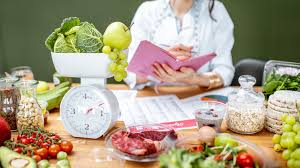Key takeaways
- For a happy gut, try to stock your fridge and pantry with whole, natural foods that contain pre- and probiotics.
- Organize your space and designate areas for types of food prep to create a “flow” that makes it easy to navigate.
- Nutrition expert Jared Meacham shares some tips about creating a gut-healthy kitchen. Hint: it doesn’t have to involve tons of cooking. With the right tools, there are plenty of quick, easy options.
Tummy. Stomach. Gut. Gastrointestinal (GI) tract. So many names, even more microorganisms — at least 100 trillion in fact. Most of these are important for your digestive health. Other, less helpful microorganisms can affect your GI tract in negative ways.
Gut health, in short, refers to the diversity and balance of around 200 different species of bacteria, viruses, and fungi in your digestive tract. Most microorganisms in your gut are meant to help you digest food, stabilize your metabolism, lower gut inflammation, and more.
If your gut has been acting a little funky lately, it’s most likely trying to tell you something about what you’ve been eating. Listening to your body and prioritizing your gut health can help improve your overall health as well.
Getting started | food & nutrition
Before we get into it, let’s refresh on two things that are essential to keeping your gut health in check: probiotics and prebiotics.
If fiber and whole, natural foods are not a staple for your diet, try and focus your attention on eating foods that contain more prebiotics.
If you’re eating whole foods like vegetables and high fiber foods but know you’re not getting enough probiotics (fermented foods), try and make that your focus to rebuild your microbiome.
Probiotics = living, friendly bacteria
these help along good digestion and the absorption of nutrients
Prebiotics = types of fiber
these feed and fuel the probiotic bacteria that comes into your gut
Staples for gut health
Healthy eating ideally consists of having at least half your plate filled with vegetables and fruits. “Prioritize accessibility to staple foods that make up 80% of your healthy diet,” Dr. Meacham suggests.
Let’s break it down further.
Pre- and probiotics
These foods contain ingredients that help provide your gut with the bacteria it needs to do its job of keeping you healthy.
High fiber and starch resistant foods (prebiotics)*
- nuts and seeds
- whole grains
- legumes
- vegetables
- fruits
Foods with live, gut-friendly bacteria (probiotics)*
- sauerkraut
- kimchi
- Greek yogurt
- kombucha
- tempeh
- miso
Other gut-friendly foods
These ingredients help with everything from lining your GI tract to providing anti-inflammatory and antioxidant effects and more.
Foods that contain anti-inflammatory polyphenols*
- olive oil
- organic dark chocolate
- red wine
- berries
- green tea
Foods rich in collagen, which may help protect the gut lining*
- beef and pork bone broth
- chicken and fish skin
- organ meats
- gelatin
- supplements with collagen
*Note that these are not exhaustive lists. Adjust as you need to, and avoid anything that makes your gut feel worse.
Grab and go
Keep small servings of easy-to-pick-up snacks like seeds, nuts, or grapes
High water fruits
Berries, plums, apples, and oranges make for healthy, filling snacks
Baked or roasted meats
These can be the basis of just about any meal, and fairly quickly
Frozen fruits, veggies, and bread
These can be huge time savers, suitable to use in a variety of dishes
Ultimately it’s the prebiotics that are going to feed and nourish the probiotics that need to be maintained in order to optimize immunity, digestion, and absorption.
Creating your healthy kitchen: How to get started
Think of your kitchen like a huge bag that has your all-day essentials inside. Over time you gather receipts, change, chapstick, and other items you might need. Sometimes you throw these things in, other times you try and place them mindfully.
But then, at the end of the day, you need your keys. And you look down and see everything you’ve accumulated except for those shiny, metal prongs.
Dr. Meacham shares that “creating a clutter-free kitchen helps you maintain a mentality of healthfulness…[A cluttered kitchen] can overwhelm the senses and cause us to be less mindful of our relationship with the foods we are preparing.”
When you’re trying to commit to eating healthier, having a clutter-free environment may make things easier.
Create your “flow state”
After identifying what you need to get your gut back on track food-wise, consider your kitchen space and where you’d like to see everything. Consider the “flow of work” you’ll need to follow to get from point A (i.e., the fridge) to point Z (i.e., the oven).
“By designating spaces for various foods and equipment, your movement through your kitchen becomes efficient and logical,” says Dr. Meacham. “This minimizes rushing around and trying to locate essential tools by ensuring all of your kitchen equipment is mindfully stored.”
Storage and placements
Before placing your items, get a feel for how you’ll be moving around the kitchen, whether that’s blending a smoothie or making a sandwich.
Keeping foods that aren’t part of your healthy eating plan out of sight may help limit cravings.
“Create a store,” Dr. Meacham suggests. In a scenario where you’re starting to make your meal, think of it as grocery shopping to get your ingredients together. Try and prep your food near to where you’ll finish cooking.
If space is limited, you might consider a rolling table or island as your prep station or finishing section. You can hold foods here, prepare them, and then move them to wherever they need to go.
In terms of storing foods, Dr. Meacham shares what goes best in the pantry, fridge, and freezer below:
Pantry items
Keep the pantry dry, cool, and dark.
- seasonings and spices
- teas, coffee, etc.
- whole grains
- canned and preserved (jarred) foods
- bananas (best at room temperature)
Fridge items
Maintain a temperature of 41°F. Temps are cooler in the back, warmer in the front.
- vegetables
- fruits like citrus, berries, and apples
- dairy products
- fermented foods
- proteins
By having designated spaces for all of the items in your kitchen, you [help] create a healthy and sanitary process of food preparation that is enjoyable and stress-free.
Freezer items
Anything you want to eat at a later date or time.
- breads or grain products
- proteins or meat products
- frozen produce
- homemade foods to eat later
Other tips
If the pantry isn’t cool, store these products in the fridge.
- oils
- nuts & seeds
- nut butters
Essential tools to keep in a gut-friendly kitchen
Now that you’ve got a layout in mind, it’s time to make sure you have the necessary tools to help you keep a healthy kitchen for gut health. Here are some options of the types of materials to make your meal prepping more convenient.
Action plan: One step at a time
Getting everything together is one thing, but implementing new steps and habits is another. If there’s one tip to remember, it’s to take things one step at a time and be kind to yourself.
Bumps in the road are common and almost expected. It’s OK to give yourself leeway, and the key is to keep your intention in mind when setting these goals for yourself.
Dr. Meacham recommends that “anytime you make a food choice that doesn’t align with your healthy plan, restart your healthy eating approach immediately. Avoid allowing one unplanned ‘mishap’ to derail your healthy eating progress.”
Avoid the ‘starting on Monday’ mentality. Instead, start now. There are an endless number of Mondays in front of us. If we rely on this mentality, we do more starting over than moving forward.
If you’re into meal prepping or it’s something you’re trying, another goal could be to prepare lean proteins in bulk.
“This will usually be something like cooking a number of chicken breasts, a couple steaks, pork chops, or [another form of protein],” Dr. Meacham says. “By preparing quality, lean proteins, you minimize kitchen time and increase the likelihood of sticking to your healthy dietary approach.”
Other tips for keeping a healthy kitchen for gut health
If you’re finding it difficult to consume sufficient amounts of the foods that help your gut, there are alternative options you can try. Because it’s important to have a balanced amount of pre- and probiotics, try taking probiotic supplements with your meals to help your gut health. Here are a few suggestions:
If your schedule or other factors make it difficult for you to prep food, buy groceries, or cook meals, you might consider premade meal options or meal kits.
If cooking isn’t your thing, focus on foods that are easy to put together quickly, but still meet the standards of quality that promote a healthy gut.
Most meal kit and prepared meal delivery services provide high quality produce and food. Some even have customized menus that cater to different diet preferences, like keto, Mediterranean, or vegan.
If you do decide to go grocery shopping, keep these tips in mind to help you stay on track while stocking your kitchen:
- go grocery shopping after eating, as shopping on an empty stomach can lead to buying foods that are high in sugar and calories
- shop the perimeter of the store first — this is where most of the high quality, whole, natural foods are
- prioritize single-ingredient foods over processed foods
- avoid buying sweetened or sugary beverages like sodas, which are a central component of the overconsumption of calories
- use frozen foods to your advantage by buying items like frozen fruits and veggies, which last longer and can mix into anything from stir fry to smoothies
Takeaways
Gut health is important not only for digestion, but for your overall being. It may help to try to create an uncluttered kitchen space that makes it easier to prep food, cook a meal every once in a while, or make a quick healthy snack.
If you’re new to this approach, remember that it takes time to learn and adapt to new processes and habits. As long as you’re consistent, intentional, and true to your needs, you can take steps to support your gut health and create a gut-friendly kitchen.














